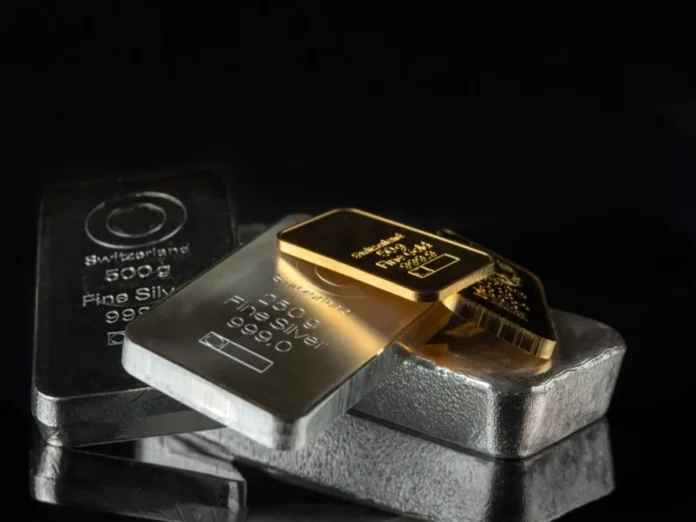Gold and silver prices experienced a notable drop on January 6, 2025, following a sharp decline in the stock market. The bullion market saw a downward trend, with 24-carat gold becoming cheaper by an average of ₹556 per 10 grams, opening at ₹76,948. Similarly, silver prices fell by ₹553 per kilogram, starting the day at an average rate of ₹87,568 per kg. This development highlights the intricate relationship between precious metals and the stock market, a dynamic that investors closely monitor for portfolio diversification and wealth preservation.
The Stock Market’s Influence On Precious Metals
The prices of gold and silver are often inversely related to the stock market’s performance. When equities fall, investors tend to flock to precious metals as a safe-haven investment, driving prices up. However, the latest dip in gold and silver prices despite a declining stock market suggests a complex interplay of global and domestic factors.
Economic uncertainty, geopolitical tensions, and currency fluctuations are known to influence the bullion market. In this case, the strengthening of the US dollar and a rise in bond yields may have contributed to the drop in gold and silver prices, as these factors typically reduce the appeal of non-yielding assets like precious metals.
Why Gold And Silver Are Key Investment Assets?
Gold and silver have historically been considered reliable stores of value, particularly during economic downturns. Gold, often referred to as the “ultimate hedge,” provides a cushion against inflation and currency depreciation. Similarly, silver, with its dual role as a precious and industrial metal, offers diversification benefits for investors.
The Indian market has a deep cultural and economic connection with gold and silver, making these metals an integral part of the country’s financial ecosystem. From weddings to festivals, the demand for gold and silver peaks during specific times of the year, influencing their prices. However, the recent decline indicates a temporary correction rather than a long-term trend.
24-Carat Gold Prices Drop By ₹556
The drop in 24-carat gold prices by ₹556 per 10 grams marks a significant shift in the bullion market. This decline brings the average rate to ₹76,948, making it an attractive buying opportunity for retail investors and jewelry buyers. Market experts believe that this dip could be short-lived, given gold’s strong fundamentals and its role as a hedge against inflation.
Gold prices are also affected by global factors, including central bank policies and international demand. Recent data suggests that central banks, especially in emerging markets, continue to accumulate gold reserves, which could support prices in the medium to long term.
Silver Prices Decline By ₹553 Per Kilogram
Silver, often referred to as “poor man’s gold,” witnessed a similar decline, falling by ₹553 per kilogram to an average rate of ₹87,568. While silver is primarily seen as an investment asset, its industrial applications in electronics, solar panels, and medical equipment add another layer of complexity to its price movements.
The recent drop in silver prices can be attributed to reduced industrial demand amid fears of a global economic slowdown. However, the ongoing push for renewable energy and advancements in technology are expected to drive silver demand in the long run, potentially stabilizing prices.
Global Factors Impacting The Bullion Market
Several global factors have contributed to the decline in gold and silver prices. The strengthening of the US dollar is one of the primary reasons, as it makes precious metals more expensive for holders of other currencies. Additionally, rising bond yields offer better returns compared to gold and silver, diverting investor interest away from bullion.
Geopolitical developments, including tensions in the Middle East and uncertainty surrounding global trade policies, also play a significant role in shaping market sentiment. These factors underscore the importance of monitoring global trends when investing in gold and silver.
Domestic Trends In The Indian Bullion Market
In India, gold and silver prices are heavily influenced by import duties, currency exchange rates, and seasonal demand. The recent decline in prices has sparked interest among retail buyers, particularly during the ongoing wedding season. Jewelers across the country are witnessing increased footfall as consumers take advantage of the lower prices to purchase gold and silver ornaments.
At the same time, traders and investors are closely watching the Reserve Bank of India’s monetary policy and its impact on the Indian rupee. A weaker rupee typically increases the cost of gold and silver imports, which could reverse the current downward trend in prices.
Opportunities For Investors
The recent decline in gold and silver prices presents an opportunity for both short-term traders and long-term investors. For traders, price volatility offers avenues for profit through buying and selling at opportune moments. For long-term investors, the current dip could serve as a strategic entry point to accumulate these assets for portfolio diversification and wealth preservation.
Experts advise investors to consider their financial goals and risk appetite before investing in gold and silver. Diversification across asset classes, including equities, fixed income, and bullion, can help mitigate risks and optimize returns.
The Future Outlook For Gold And Silver
While the current drop in prices may seem concerning to some, the long-term outlook for gold and silver remains positive. As economic uncertainties persist and inflationary pressures build, the demand for safe-haven assets is expected to grow. Additionally, industrial advancements and green energy initiatives will likely bolster silver demand, supporting its prices over time.
For now, the decline in gold and silver prices serves as a reminder of the dynamic nature of financial markets. Investors and consumers alike must stay informed about global and domestic trends to make prudent decisions regarding these timeless assets.



